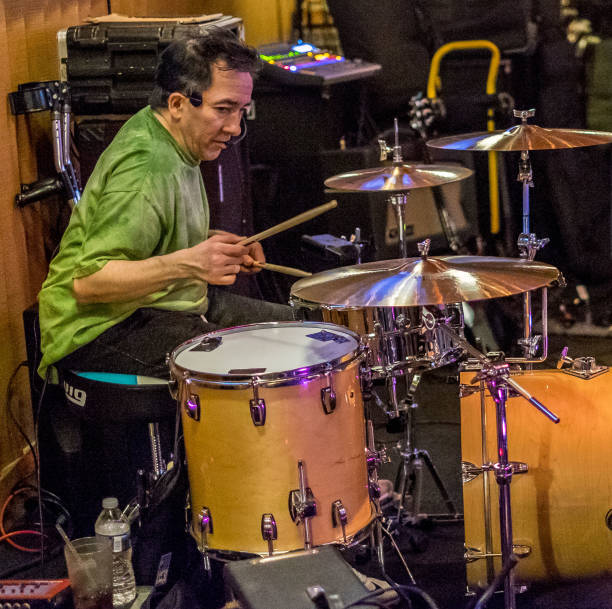Every drummer should have the answer to the question, What is a Drum Trigger?.Triggers are an important aspect in modern drumming.Technology and electronic drumming have always been prevalent in music, all the way back to the 70s. However, electronic drum sounds have become a lot more accessible these days, largely due to the use of triggers.
With the use of triggers, you can create a hybrid drum kit setup. You’ll get all the sounds of your acoustic drums and cymbals, but you’ll be able to play electronic sounds using your drums as well.
We’re going to take a deep dive into understanding drum triggers and how they work.
What are Drum Triggers?

How Drum Triggers Work? Well the answer is a bit elaborate than one might think it is. Drum triggers are small pieces of gear that you attach to acoustic drums. When you play the drums they’re attached to, sensors are triggered and sent through to a module that produces electronic sounds. This signal is then used to trigger or activate a variety of electronic sounds or samples.
In essence, a drum trigger enables drummers to blend the world of acoustic and electronic percussion, expanding their creative horizons and the soundscape of their performances.
There are a wide variety of triggers available out there, with the most common ones being clip-on triggers. You also get piezo triggers, which have an adhesive material that sticks to the surfaces of your drums.
The quality of a trigger depends on how they’re built and how much it costs. Some triggers have dual sensors, allowing you to play the drums and rims to get different sounds. Other triggers only have single sensors.
You need to buy specific triggers for kick drums. They’re designed to fit them, whereas standard triggers won’t clip on as easily, and they won’t react as well as dedicated bass drum triggers.
How Does a Drum Trigger Work?
The magic of a drum trigger lies in its ability to sense and respond to the drummer’s strikes on the drum kit. Triggers connect to the drums either by the rim, attaching to the top or bottom, or being positioned inside the shell. When you hit the drums, the triggers sense the vibrations and send a signal through to the module or interface that they’re connected to.
The module will have particular sounds assigned to each trigger. So, when you hit the triggered drum, the specified sound will play.
This is how you can get electronic drum sounds from playing acoustic drums. However, people also use triggers instead of drum microphones occasionally. They give you more control over the drum sound than mics do, but some people don’t like the processed drum trigger sound.
Some drummers only put triggers on their snare drum or bass drum, while others put them everywhere to get a full hybrid setup.
The Drum Trigger Guide for Beginners that I talk about here has the important component of the simplified breakdown of how it works:
1. Attachment:
A drum trigger is attached to a specific part of a drum kit, such as the drumhead, drum rim, or cymbal. It is secured in place using adhesive or clamps, ensuring it stays in position during vigorous drumming sessions.
2. Sensitivity:
The trigger is equipped with sensors that are highly sensitive to vibrations and impacts. When the drummer strikes the drum or cymbal with a drumstick or mallet, these sensors detect the resulting vibrations.
3. Signal Generation:
Upon detecting a hit, the drum trigger generates an electrical signal. This signal varies in strength and duration based on the intensity and duration of the impact.
4. Sound Generation:
The electrical signal is sent to an electronic drum module or sound module.
This module processes the signal and produces a corresponding sound, which can be customized to emulate various drum or percussion instruments. The result is a seamless blend of acoustic and electronic sounds.
Whether it’s an external trigger or an electronic drum pad, piezo (piezoelectric) sensors are used to detect the stick’s strike. Piezo sensors consist of a small, brass disc with a very thin quartz disc layered on top, and with drum and cymbal pads, they are protected by rubber or foam discs. Once electric leads are attached to the brass and quartz discs, the piezo will almost act like a microphone’s diaphragm.
When the sensor is attached to a surface like a rubber drum pad or an external trigger’s foam disc, it will measure pressure and vibration changes, then convert them into an electrical charge (voltage). For drum triggers, this spike sends this voltage through the cable, which triggers the sound on your drum module. The softer you hit a pad, the less voltage is sent, resulting in a quieter sound. Conversely, the harder you hit a pad, the more voltage is sent, resulting in a much louder sound.
Sensors in Drums
Electronic drum pads will almost always use a standard-size piezo sensor on the center of the pad. If you have dual- or triple-zone pads, there will be a few different spots on the pad where they may be located. The Electronic Drum Triggers
External triggers come in a few different shapes and sizes, and they have more flexibility in placement. Most acoustic drum triggers are clamped acoustic drum’s rim, but some manufacturers have also created conversion kits where you can place a trigger inside the drum.
Dual- and triple-zone drum pads
If you have a dual- or triple-zone drum pad, it will have multiple piezo sensors. These sensors are positional, meaning one piezo will trigger a specific part of a pad, and another will trigger a different section.
For example, in dual-zone snare pads, one piezo is located in the center. The other is on or near the rim. This means any time you hit the rim, it will trigger a different sound than the piezo in the center.
Cymbal switches
A cymbal pad with multiple zones can also have a pressure switch that sends ON/OFF messages when touched.
The switch works in conjunction with the piezo. As the name implies, it sends ON and OFF information. A piezo switch often utilizes a piezo and a membrane or a ribbon. If you strike the piezo switch, it will produce a sound (ON), but when the membrane/ribbon is pinched, it will cut the sound out (OFF).
If you hit the switch and the piezo is triggered, it will trigger a particular sound (for example, edge or crash) and turn OFF once the switch is pinched.
TRS vs. TS Cables
Almost all modules that come with cables will include TRS cables. This is important because, while you can use standard TS cables, those will only trigger the “primary” sensor. So, if you have a TS cable connected to a dual-zone snare pad, the module will always trigger just the snare sound.
TRS cables are used for balanced connections, but for electronic drum pads, TRS cables are associated with the piezo sensors. Here is how a cable works with drum and cymbal pads.
- Drum pads
- Tip: drumhead sensor
- Ring: rim sensor
- Sleeve: ground
- Cymbal pads:
- Tip: ground
- Ring: bell/edge sensor
- Sleeve: bow sensor
Triple-zone cymbal pads
The exception to this rule is triple-zone cymbal pads, as the TRS cable can only handle the edge and bow signal. So, if you have a triple-zone pad, like a triple-zone ride cymbal pad, there will be an additional input on the module specifically for the third zone.
While it is uncommon, some manufacturers can utilize one cable to handle all three zones.
The Advantages of Drum Triggers
The Best Uses for Drum Triggers are as follows:
1. Sound Versatility:
Drummers can access an extensive array of sounds, ranging from traditional drum tones to exotic percussion instruments and electronic effects. This versatility is invaluable for artists exploring diverse musical genres and styles.
2. Consistency:
Drum triggers provide consistent and precise triggering, reducing variations in sound that can occur when playing purely acoustic drums. This ensures a reliable and polished performance.
3. Quiet Practice:
By using drum triggers with electronic drum kits, drummers can practice silently with headphones, making them an excellent choice for situations where noise control is essential.
4. Recording Flexibility:
In recording studios, drum triggers allow sound engineers to capture the drum hits independently of the acoustic drum sounds. This flexibility provides greater control over the mix and enhances the overall sound production.
5. Live Performance:
Drum triggers are frequently employed in live performances, enabling drummers to seamlessly incorporate electronic elements into their sets. This dynamic fusion of acoustic and electronic percussion enhances the overall live experience.
FAQS
- How do you trigger drum sounds?
You need to attach drum triggers to your drums, run those through to an electronic drum or trigger module, and then plug that into a sound source. When you select sounds on the module, they’ll be triggered when you strike the corresponding drums.
All trigger modules come with preset sounds that you can use. However, many drummers opt to add their own sample sounds as well. You’ll see this happening a lot for live gigs where a band is playing songs from an album. It’ll be the drummer’s job to play those sounds. It’s all done with triggers.
One of the best triggers on the market to get is the Roland RT-30HR. It’s a dual trigger, meaning you can trigger drum sounds when playing both the drumhead and rim of the drum it’s attached to.
- How does a kick trigger work?
Kick triggers work the same way normal triggers work that you attach to your drums. However, they’re positioned slightly differently, thanks to the way kick drums are structured.
Another difference is that kick triggers only have to have single trigger zones. This is because kick drums only make one sound, and having two trigger zones wouldn’t allow you to play a second sound anyway.
- How do I connect drum triggers to my computer?
You need to connect the triggers to a drum or trigger module first. That’s the only easy way to do it. Once you have that, you can connect the module to a computer. This is a great way of recording your drums as opposed to using drum mics.
You can also download a drum VST to get superior drum sounds to what you have on your module. One of the best VST programs for this is called EZdrummer.
However, the power of triggers is getting to play electronic sounds with your drums, and there are thousands of great VSTs that will allow you to do that. You can also run sounds from free software such as GarageBand.
